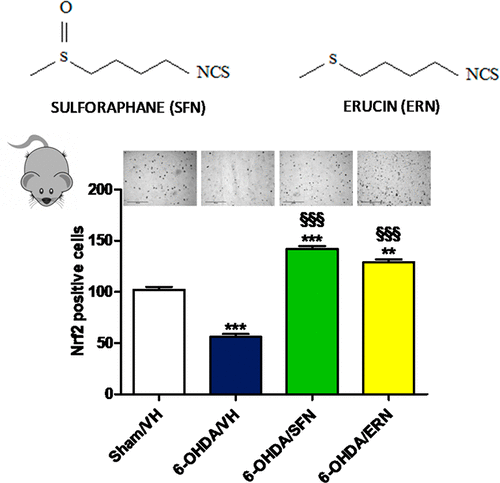当前位置:
X-MOL 学术
›
J. Agric. Food Chem.
›
论文详情
Our official English website, www.x-mol.net, welcomes your
feedback! (Note: you will need to create a separate account there.)
Comparison of Adaptive Neuroprotective Mechanisms of Sulforaphane and its Interconversion Product Erucin in in Vitro and in Vivo Models of Parkinson’s Disease
Journal of Agricultural and Food Chemistry ( IF 5.7 ) Pub Date : 2018-01-07 00:00:00 , DOI: 10.1021/acs.jafc.7b04641 Fabiana Morroni 1 , Giulia Sita 1 , Alice Djemil 2 , Massimo D’Amico 3 , Letizia Pruccoli 3 , Giorgio Cantelli-Forti 3 , Patrizia Hrelia 1 , Andrea Tarozzi 3
Journal of Agricultural and Food Chemistry ( IF 5.7 ) Pub Date : 2018-01-07 00:00:00 , DOI: 10.1021/acs.jafc.7b04641 Fabiana Morroni 1 , Giulia Sita 1 , Alice Djemil 2 , Massimo D’Amico 3 , Letizia Pruccoli 3 , Giorgio Cantelli-Forti 3 , Patrizia Hrelia 1 , Andrea Tarozzi 3
Affiliation

|
Several studies suggest that an increase of glutathione (GSH) through activation of the transcriptional nuclear factor (erythroid-derived 2)-like 2 (Nrf2) in the dopaminergic neurons may be a promising neuroprotective strategy in Parkinson’s disease (PD). Among Nrf2 activators, isothiocyanate sulforaphane (SFN), derived from precursor glucosinolate present in Brassica vegetables, has gained attention as a potential neuroprotective compound. Bioavailability studies also suggest the contribution of SFN metabolites, including erucin (ERN), to the neuroprotective effects of SFN. Therefore, we compared the in vitro neuroprotective effects of SFN and ERN at the same dose level (5 μM) and oxidative treatment with 6-hydroxydopamine (6-OHDA) in SH-SY5Y cells. The pretreatment of SH-SY5Y cells with SFN recorded a higher (p < 0.05) active nuclear Nrf2 protein (12.0 ± 0.4 vs 8.0 ± 0.2 fold increase), mRNA Nrf2 (2.0 ± 0.3 vs 1.4 ± 0.1 fold increase), total GSH (384.0 ± 9.0 vs 256.0 ± 8.0 μM) levels, and resistance to neuronal apoptosis elicited by 6-OHDA compared to ERN. By contrast, the simultaneous treatment of SH-SY5Y cells with either SFN or ERN and 6-OHDA recorded similar neuroprotective effects with both the isothiocyanates (Nrf2 protein 2.2 ± 0.2 vs 2.1 ± 0.1 and mRNA Nrf2 2.1 ± 0.3 vs 1.9 ± 0.2 fold increase; total GSH 384.0 ± 4.8 vs 352.0 ± 6.4 μM). Finally, in vitro finding was confirmed in a 6-OHDA-PD mouse model. The metabolic oxidation of ERN to SFN could account for their similar neuroprotective effects in vivo, raising the possibility of using vegetables containing a precursor of ERN for systemic antioxidant benefits in a similar manner to SFN.
中文翻译:

萝卜硫素及其相互转化产品Erucin自适应神经保护机制的比较在体外和体内帕金森氏病的模型
多项研究表明,通过激活多巴胺能神经元中的转录核因子(类胡萝卜素衍生的2)样2(Nrf2)来增加谷胱甘肽(GSH)可能是帕金森氏病(PD)的一种有前途的神经保护策略。在Nrf2活化剂中,源自芸苔属植物蔬菜中存在的芥子油苷的异硫氰酸盐萝卜硫烷(SFN)作为潜在的神经保护化合物受到了关注。生物利用度研究还表明,SFN代谢产物(包括芥酸(ERN))对SFN的神经保护作用有贡献。因此,我们比较了体外相同剂量水平(5μM)的SFN和ERN的神经保护作用以及用6-羟基多巴胺(6-OHDA)氧化处理SH-SY5Y细胞的神经保护作用。用SFN预处理SH-SY5Y细胞记录了较高的(p <0.05)活性核Nrf2蛋白(12.0±0.4 vs 8.0±0.2倍增加),mRNA Nrf2(2.0±0.3 vs 1.4±0.1倍增加),总GSH( 384.0±9.0 vs 256.0±8.0μM)水平,与ERN相比,6-OHDA引起的对神经元凋亡的抵抗力。相比之下,同时用SFN或ERN和6-OHDA处理SH-SY5Y细胞对异硫氰酸酯的神经保护作用均相似(Nrf2蛋白2.2±0.2 vs 2.1±0.1和mRNA Nrf2 2.1±0.3 vs 1.9±0.2倍增加;总GSH 384.0±4.8与352.0±6.4μM)。最后,体外在6-OHDA-PD小鼠模型中证实了这一发现。ERN代谢为SFN可能在体内具有类似的神经保护作用,从而增加了使用含有ERN前体的蔬菜以类似于SFN的方式获得系统性抗氧化功效的可能性。
更新日期:2018-01-07
中文翻译:

萝卜硫素及其相互转化产品Erucin自适应神经保护机制的比较在体外和体内帕金森氏病的模型
多项研究表明,通过激活多巴胺能神经元中的转录核因子(类胡萝卜素衍生的2)样2(Nrf2)来增加谷胱甘肽(GSH)可能是帕金森氏病(PD)的一种有前途的神经保护策略。在Nrf2活化剂中,源自芸苔属植物蔬菜中存在的芥子油苷的异硫氰酸盐萝卜硫烷(SFN)作为潜在的神经保护化合物受到了关注。生物利用度研究还表明,SFN代谢产物(包括芥酸(ERN))对SFN的神经保护作用有贡献。因此,我们比较了体外相同剂量水平(5μM)的SFN和ERN的神经保护作用以及用6-羟基多巴胺(6-OHDA)氧化处理SH-SY5Y细胞的神经保护作用。用SFN预处理SH-SY5Y细胞记录了较高的(p <0.05)活性核Nrf2蛋白(12.0±0.4 vs 8.0±0.2倍增加),mRNA Nrf2(2.0±0.3 vs 1.4±0.1倍增加),总GSH( 384.0±9.0 vs 256.0±8.0μM)水平,与ERN相比,6-OHDA引起的对神经元凋亡的抵抗力。相比之下,同时用SFN或ERN和6-OHDA处理SH-SY5Y细胞对异硫氰酸酯的神经保护作用均相似(Nrf2蛋白2.2±0.2 vs 2.1±0.1和mRNA Nrf2 2.1±0.3 vs 1.9±0.2倍增加;总GSH 384.0±4.8与352.0±6.4μM)。最后,体外在6-OHDA-PD小鼠模型中证实了这一发现。ERN代谢为SFN可能在体内具有类似的神经保护作用,从而增加了使用含有ERN前体的蔬菜以类似于SFN的方式获得系统性抗氧化功效的可能性。











































 京公网安备 11010802027423号
京公网安备 11010802027423号